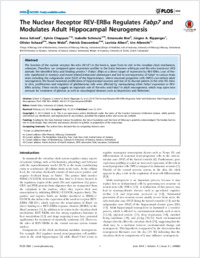The nuclear receptor REV-ERBα regulates Fabp7 and modulates adult hippocampal neurogenesis
- Schnell, Anna Dept. of Biology, Unit of Biochemistry, University of Fribourg, Switzerland
- Chappuis, Sylvie Dept. of Biology, Unit of Biochemistry, University of Fribourg, Switzerland
- Schmutz, Isabelle Dept. of Biology, Unit of Biochemistry, University of Fribourg, Switzerland
- Brai, Emanuele Dept. of Medicine, Unit of Anatomy, University of Fribourg, Switzerland
- Ripperger, Jürgen A. Dept. of Biology, Unit of Biochemistry, University of Fribourg, Switzerland
- Schaad, Olivier NCCR frontiers in Genetics, University of Geneva, Switzerland
- Welzl, Hans Dept. of Anatomy, University of Zürich, Switzerland
- Descombes, Patrick NCCR frontiers in Genetics, University of Geneva, Switzerland
- Alberi, Lavinia Dept. of Medicine, Unit of Anatomy, University of Fribourg, Switzerland
- Albrecht, Urs Dept. of Biology, Unit of Biochemistry, University of Fribourg, Switzerland
-
16.06.2014
Published in:
- PLoS ONE. - 2014, vol. 9, no. 6, p. e99883
English
The function of the nuclear receptor Rev-erbα (Nr1d1) in the brain is, apart from its role in the circadian clock mechanism, unknown. Therefore, we compared gene expression profiles in the brain between wild-type and Rev-erbα knock-out (KO) animals. We identified fatty acid binding protein 7 (Fabp7, Blbp) as a direct target of repression by REV-ERBα. Loss of Rev-erbα manifested in memory and mood related behavioral phenotypes and led to overexpression of Fabp7 in various brain areas including the subgranular zone (SGZ) of the hippocampus, where neuronal progenitor cells (NPCs) can initiate adult neurogenesis. We found increased proliferation of hippocampal neurons and loss of its diurnal pattern in Rev-erbα KO mice. In vitro, proliferation and migration of glioblastoma cells were affected by manipulating either Fabp7 expression or REV-ERBα activity. These results suggest an important role of Rev-erbα and Fabp7 in adult neurogenesis, which may open new avenues for treatment of gliomas as well as neurological diseases such as depression and Alzheimer.
- Faculty
- Faculté des sciences et de médecine
- Department
- Département de Biologie, Médecine 3ème année
- Language
-
- English
- Classification
- Biological sciences
- License
- License undefined
- Identifiers
-
- RERO DOC 211447
- DOI 10.1371/journal.pone.0099883
- Persistent URL
- https://folia.unifr.ch/unifr/documents/303789
Statistics
Document views: 150
File downloads:
- alb_nrr.pdf: 128
